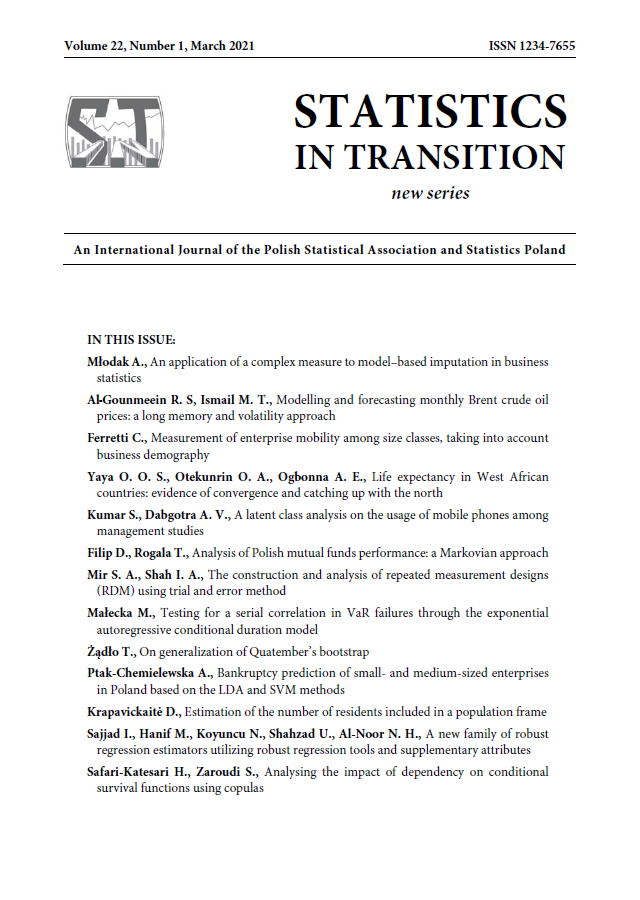ARTICLE
ABSTRACT
Nowadays, insurance contract reserves for coupled lives are considered jointly, which has a significant influence on the process of determining actuarial reserves. In this paper, conditional survival distributions of life insurance reserves are computed using copulas. Subsequently, the results are compared with an independence case. These calculations are based on selected Archimedean copulas and apply when the ‘death of one individual’ condition exists. The estimation outcome indicates that the insurer reserves calculated by means of Archimedean copulas are far more effective than those resulting from an independence assumption. The study demonstrates that copula-based dependency modelling improves the calculations of reserves made for actuarial purposes.
KEYWORDS
conditional survival distribution, copula, Kendall’s tau, reserves, life table
REFERENCES
CARRIERE, J. F., (2000). Bivariate survival models for coupled lives. Scandinavian Actuarial Journal, (1), pp. 17–32.
DENUIT, M., DHAENE, J., GOOVAERTS, M., and KAAS, R., (2005). Actuarial theory for dependent risks: measures, orders and models. John Wiley and Sons.
FREES, E. W., VALDEZ, E. A., (1998). Understanding relationships using copulas. North American actuarial journal, 2(1), pp. 1–25.
GENEST, C., MACKAY, J., (1986a). The joy of copulas: Bivariate distributions with uniform marginals. The American Statistician, 40(4), pp. 280–283.
GENEST, C., MACKAY, R. J., (1986b). Copules archimédiennes et families de lois bidimensionnelles dont les marges sont données. Canadian Journal of Statistics, 14(2), pp. 145–159.
GERBER, H. U., (1997). Life insurance mathematics. Springer Science and Business Media.
HOUGAARD, P., (2000). Analysis of multivariate survival data. Springer Science and Business Media.
JI, M., HARDY, M., and LI, J. S. H., (2011). Markovian approaches to joint-life mortality. North American Actuarial Journal, 15(3), pp. 357–376.
KATESARI, H. S., VAJARGAH, B. F., (2015). Testing Adverse Selection Using Frank Copula Approach in Iran Insurance Markets. Journal of mathematics and computer Science. 15(2), pp. 154–158.
KATESARI,H. S., ZARODI, S., (2016). Effects of Coverage Choice by Predictive Modeling on Frequency of Accidents. Caspian Journal of Applied Sciences Research, 5(3), pp. 28–33.
KLUGMAN, S. A., PARSA, R., (1999). Fitting bivariate loss distributions with copulas. Insurance: mathematics and economics, 24(2), pp. 139–148.
LEE, I., LEE, H. and KIM, H.T., (2014). Analysis of reserves in multiple life insurance using copula. Communications for Statistical Applications and Methods, 21(1), pp. 23–43.
MARI, D., KOTZ, S., (2004). Correlation and Dependent. Imperial College Press.
NELSEN, R. B., (2006). An Introduction to Copulas. Springer Science and Business Media.
SAFARI-KATESARI, H., ZAROUDI, S., (2020). Count copula regression model using generalized beta distribution of the second kind. Statistics in Transition New Series, 21(2), pp. 1–12.
SKLAR, M., (1959). Fonctions de repartition an dimensions et leurs marges. Publ. inst. statist. univ. Paris, 8, pp. 229–231.
SPREEUW, J., (2006). Types of dependence and time-dependent association between two lifetimes in single parameter copula models. Scandinavian Actuarial Journal, 5, pp. 286–309.
SPREEUW, J., OWADALLY, I., (2013). Investigating the broken-heart effect: a model for short-term dependence between the remaining lifetimes of joint lives. Annals of Actuarial Science, 7(2), pp. 236–257.
ZAROUDI, S., BEHZADI, M. H., and FARIDROHANI, M. R., (2018a). Application of Copula in Life Insurance. International Journal of Applied Mathematics and StatisticsTM, 57(3), pp. 162–168.
ZAROUDI, S., BEHZADI, M. H., and FARIDROHANI, M. R., (2018b). A Copula Approach for Finding the Type of Dependency with Mortality Force Function in Insurance Market. Journal of Advances and Applications in Statistics, 53(2), pp. 103–121.
